Every day solar panel companies are patenting technologies that keep them ahead of the technology curve. One of the recent additions to the front of this curve is Solyndra‘s solar panel tubes, a feat of innovation that earned the company a spot on MIT’s list of the top 50 most innovative companies list.
As described in our previous article about emerging solar panel trends the reasons for choosing a certain type of material to produce a solar panel are based on the ability to solve several complex design trade-offs.
For example, Solyndra uses a combination of Copper Indium Gallium Selenide (CIGS) to produce their solar tubes. These are not as common or as cheap as elements like Silicon, however, the combination provides other benefits that are not obvious to the average solar panel purchaser.
Some of the benefits of using CIGS to manufacture solar panels are:
- Its ability to absorb more wavelengths of light
- Relatively good performance in absorbing light of low intensity–i.e. low-light conditions
- Its ability to absorb and ‘collect’ light more efficiently*
- 20% + cell conversion efficiency (in laboratory conditions), compared to 12-14% for many silicon cells
- Its flexibility and applicability on even curved surfaces
This thin-film technology also has one of the lowest costs of production in the industry, primarily because of the minimal use of materials and the highly automated processes used to mass manufacture the tubes.

Other inherent design advantages are that it offers are: natural sun tracking thanks to its cylindrical shape, the ability to withstand larger gusts of wind and greater passive-cooling–important if the cells are to operate at optimal temperature.
Game on Silicon!
Written by Prateek Chourdia
MEngSc – Photovoltaics and Solar Energy, UNSW
Solar Energy Analyst
Solar Choice
© 2010 Solar Choice Pty Ltd
Source
http://www.solyndra.com/Products/PV-Systems
* There is a difference between ‘absorb’ and ‘collect.’ This is to differentiate between the optical efficiency and the substrate efficiency. Where optical efficiency is determined by shading etc. and substrate efficiency is effected by the chemical characteristics of the elements that make up the substrate of the cell and their ability to generate electron-hole pairs from the photons of light that enter the cell.
I have a flat roof of less than 5 degree slope which is about 50 square metre.
Is the Solyndra product an option?
What size system in kw and cost?
Solyndra is indeed an option for flat roofs, Glen. Keep in mind that there are actually different power ratings for Solyndra modules of the same dimensions (see the Solyndra spec sheet). Determining how many kilowatts of power you will be able to fit on your roof will depend on which capacity of Solyndra model you go with. Doing some (very) rough calculations, you should be able to fit about 20 modules on your roof with the space you have, so you’re looking at between about 3 and 8kW. The higher efficiency panels will be more expensive.
How much a system will cost will also depend partially on which state/REC zone you live in. There are federal solar rebates that you can usually receive up-front when you install a system.
We can provide you with a free quote comparison if you fill out a solar quote request form or call us on 1300 78 72 73. This will give you a look at the prices that are on offer from a number of installers in your local area, as well as who can install Solyndra.
is this technology available now???????
the technology is available in Aust – however only a limited number of installers currently have a supply arrangement in place. Solar Choice can broker a comparison of up to 4 installers using Solyndra, depending on which state you live in
I’m curious as to how the statement
“This thin-film technology also has one of the lowest costs of production primarily because of the minimal use of materials and the highly automated processes used to mass manufacture these tubes.”
stacks up againsts Solyndras statement that their cost of production for the quarter to January 2010 was US$4.00 per watt.
http://sec.gov/Archives/edgar/data/1443115/000119312510058567/ds1a.htm (page 4)
This makes it lower than the production cost of the solar panels NASA uses perhaps?
In this situation Solyndras statement of US $4.00 per watt is higher than other products out in the market and the $4.00 per watt can be due to a variety of factors such as high interest rate loans on the very expensive automated machines as well as they are a relatively new company as compared to Sharp or BP Solar and if one were to look at how expensive they were when they were as young as Solyndra is I think the comparison would suggest that Solyndra is a ‘lower cost’ production method. Primarily, the point that we are trying to make is that the reason why thin-film technology like Solyndra should have one of the lowest costs of production is because they use a fraction of the material that other manufacturers use to build a similar solar cell.